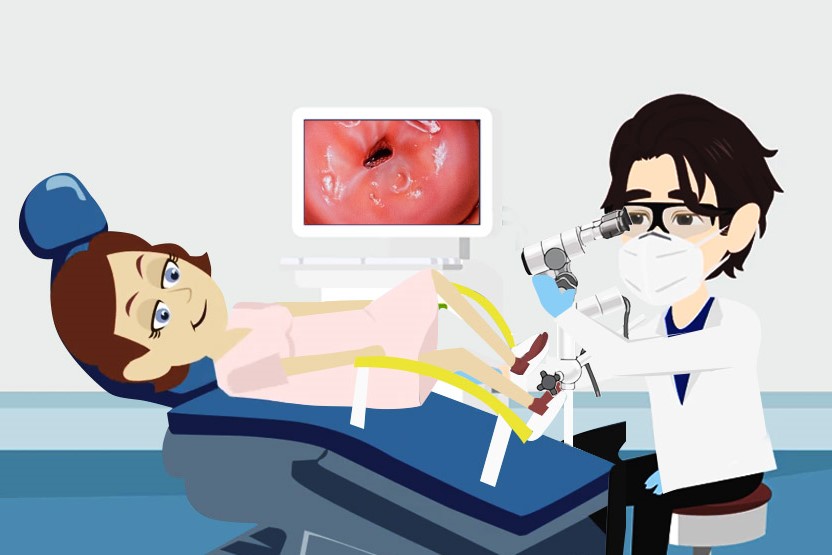
Colposcopy: what it is and what it is for
Colposcopy is a second-level test that is performed when the pap test has detected lesions or abnormalities, allowing further investigation of the condition of the tissues of the cervix and vagina
What is colposcopy?
Colposcopy is a test that is performed to diagnose the health condition of the cervix and vagina.
It is performed using an instrument called a colposcope, which allows the medical specialist to examine the areas of interest up close and through magnifying glasses, after the application of 2 reagents.
The test lasts on average about 15-20 minutes, and causes no pain.
Its main function is to detect any macroscopically detectable lesions on which it might be important to perform a targeted biopsy.
The aim is to diagnose cervical and vaginal cancers at an early stage, but it can also be very useful for the observation and analysis of other benign conditions such as condylomas.
How is colposcopy performed?
Colposcopy is performed by having the patient lie on the couch in the gynaecological position.
The gynaecologist then introduces the speculum, an instrument that stretches the walls of the vagina to show the cervix and the walls of the vagina.
A small swab is then inserted onto which a solution of first acetic acid and then iodine is applied. In this way, any tissue abnormalities are more easily identified.
Based on the picture that emerges after the application of the two reagents, the doctor will decide whether and where to perform the targeted biopsy.
Colposcopy is not a painful test, although the insertion of the solutions may sometimes create a burning sensation.
In some cases during the colposcopy, it may be necessary to take a biopsy, i.e. a small sample of tissue that will then be sent to the laboratory for histological examination.
No special precautions are necessary after the test, but small amounts of bleeding may occur in the days following the test.
How to prepare for colposcopy?
To carry out the colposcopy, it is best to schedule the test away from the menstrual flow, and, in the 24 hours prior to the test, avoid sexual intercourse and do not use vaginal insertion drugs (such as ovules, douches, candles).
Read Also
Emergency Live Even More…Live: Download The New Free App Of Your Newspaper For IOS And Android
Colposcopy: How To Prepare, How It Is Performed, When It Is Important
Cystitis: Symptoms, Causes And Remedies
Cystitis, Antibiotics Are Not Always Necessary: We Discover Non-Antibiotic Prophylaxis
Polycystic Ovary Syndrome: Signs, Symptoms And Treatment
Female Cystitis, How To Deal With It: Urological Perspectives
How Does Cystitis Manifest Itself?
Cervical Cancer: The Importance Of Prevention
Vulvodynia: What Are The Symptoms And How To Treat It
What Is Vulvodynia? Symptoms, Diagnosis And Treatment: Talk To The Expert
Accumulation Of Fluid In The Peritoneal Cavity: Possible Causes And Symptoms Of Ascites
What’s Causing Your Abdominal Pain And How To Treat It
Pelvic Varicocele: What It Is And How To Recognise The Symptoms
Can Endometriosis Cause Infertility?
Transvaginal Ultrasound: How It Works And Why It Is Important
Candida Albicans And Other Forms Of Vaginitis: Symptoms, Causes And Treatment
What Is Vulvovaginitis? Symptoms, Diagnosis And Treatment
Urinary Tract Infections: Symptoms And Diagnosis Of Cystitis
Cervical Cancer Screening, THINPrep And Pap Test: What Is The Difference?
Diagnostic And Operative Hysteroscopy: When Is It Necessary?
Techniques And Instruments For Performing Hysteroscopy
The Use Of Outpatient Hysteroscopy For Early Diagnosis
Utero-Vaginal Prolapse: What Is The Indicated Treatment?
Pelvic Floor Dysfunction: What It Is And How To Treat It
Pelvic Floor Dysfunction: Risk Factors
Salpingitis: Causes And Complications Of This Fallopian Tube Inflammation
Hysterosalpingography: Preparation And Usefulness Of The Examination
Gynaecological Cancers: What To Know To Prevent Them
Infections Of The Bladder Mucosa: Cystitis
Colposcopy: The Test Of The Vagina And Cervix


